Vet Med’s Summer Research Training Program Exposes Participants to What Careers in Veterinary Research Might Entail
October 31, 2017
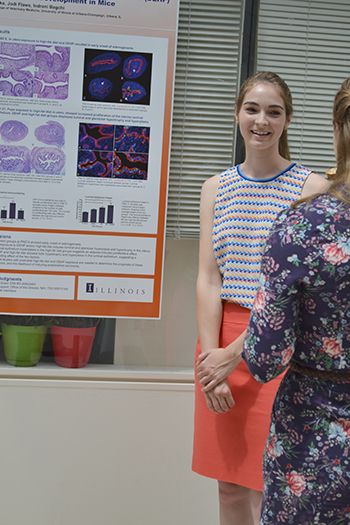
Vet Med student, Suzanna Storms, presents her research at Vet Med's end-of-summer poster session.
Every year since 2003, the Summer Research Training Program (SRTP) has hosted 14–25 veterinary school students from the University of Illinois to conduct a research project for 10 weeks over the summer. The goal of the program? To facilitate the career progression of veterinary medicine students who have the ability and motivation to become research scientists. Each of the 14 students who participated was paired with a mentor from the Illinois College of Veterinary Medicine and helped design a research project, which they participated in from beginning to end. In addition to research, they also explored future available careers, trained in research ethics, and learned about proper scientific writing. Run by Professor Lois Hoyer, the SRTP lasted from May 22nd to July 28th.
By the end of the program, participants had written an abstract and manuscript and designed a poster, all of which summarized their findings. The research poster was presented first at the College of Veterinary Medicine Symposium on August 2nd, and then again from August 3rd through the 6th at the Merial-NIH Veterinary Scholars Symposium at The National Institutes of Health, who funded the program. Additionally, participants attended weekly seminars that focused on professional career development of a research scientist.
Bridget Clancy
One student in particular who discovered a new interest in the research environment was Bridget Clancy, who is now in her second year of Veterinary Medicine’s 4-year program. Clancy entered the program having minimal lab experience, and she felt that it would be important for her to gain more due to her desire to one day become a lab animal veterinarian. Her research project was on circadian disruptions in rats and how it affects certain aspects of their behavior, specifically their impulsivity and attentiveness.
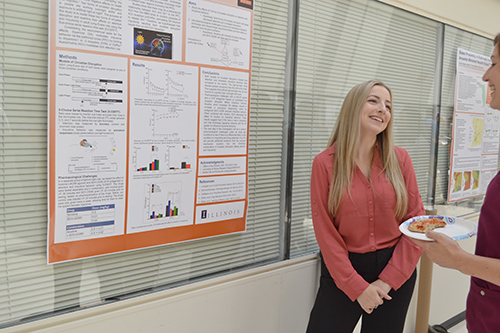
Above and Below: Bridget Clancy, second year Vet Med student.
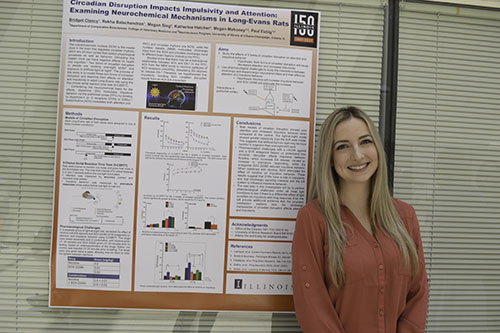
The study found that rats were indeed impacted by circadian disruptions, and they experienced decreased attention and increased impulsive behavior when compared to the control. Clancy claims that circadian disruptions can have a similar effect on humans due to “going to sleep looking at their cell phones or working overnight shifts at work… those things can affect your cognition.”
Making these connections to humans is one of Clancy’s favorite things about research: “I think discovering new things is super important and very exciting. That's a really exciting part of the veterinary career, helping to find new discoveries for people and animals that could help both human and animal health. And I think that's a really exciting part of the veterinary career as a whole.”
Clancy loved being able to complete a project from start to finish that produced concrete results. From the experience, she was also able to get to know some of her professors on a more personal basis that she would be unable to from class alone. An added bonus for her was even working with the lab rats, which she says are “quite friendly and much nicer than people think!”
Tony Bieser
Another second year student, Tony Bieser, also found the summer SRTP program particularly valuable. He had some lab experience prior to the summer, but none where he was able to participate in the planning and designing of experiments. This summer, though, he was able to experience the planning aspect of research, which he discovered is a lot more work than anticipated. He had no idea how many papers he would have to read and people he would have to talk to in order to properly plan an experiment, but through this he was able to gain a “better understanding of what it takes to start a project from the ground up.”
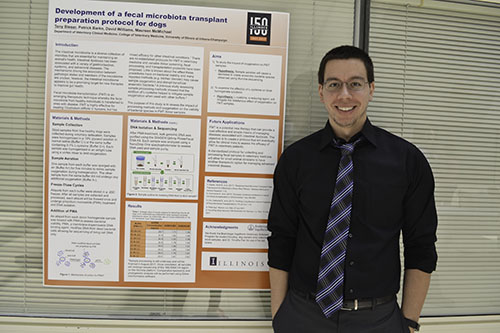
Second Year Vet Med student Tony Bieser
Bieser’s research was to design a protocol for treating intestinal illnesses in dogs using a fecal transplant procedure. This involves using different techniques to preserve stool samples from healthy dogs and processing them so they can be used in diseased dogs. However, the samples were being aerated a little too much, which decreases the total amount of anaerobic bacteria. Subsequently, the experiment was unable to produce conclusive results. But this doesn’t mean that the experiment was a failure! He plans on continuing and completing the project this fall semester, and hopes to participate in other similar studies in the lab, gaining more research experience.
Bieser especially loved this project because one of his biggest interests is gastrointestinal diseases in rabbits. Tony says there could be a strong connection between his interests and the study: “I'm hoping that the results that we get from this project can maybe be transferred over into a future project that I can do, specifically on rabbits. I think the overall impact that this can have on a number of different species down the line, I think is pretty significant.”
Nicole Sidebotham
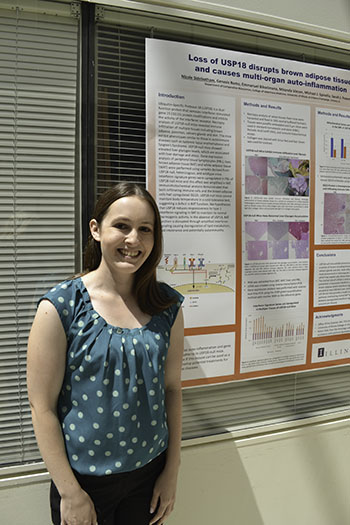
Third Year Vet Med student Nicole Sidebotham.
A third year student in the Veterinary School, Nicole Sidebotham, reports that as a result of participating in the SRTP, she was able to gain a better understanding of how she can make research part of her career. This summer gave her the opportunity to “see what life as a researcher would be like,” which she says will be particularly valuable when making career decisions down the road. “I'm definitely more interested in trying to make research a part of my career. I've gotten a few ideas on maybe how to pursue that, even if I decide to go into more of a clinical practice aspect. Definitely a lot stronger leaning towards, making research a part of my career.”
Sidebotham’s project this summer focused on looking at a specific mouse model to study autoimmune diseases and developing potential treatments for them. She found that her mouse was a great model for studying autoimmune diseases, specifically the autoinflammation and autoimmunity targeting brown fat.
Kalinda Clark
One student who had had extensive prior lab experience, Kalinda Clark, still found the SRTP program to be extremely valuable. She spent almost two years researching how nanomedicine can be used to combat cancer at Georgetown University prior to enrolling in Illinois’ Veterinary School, where she is also enrolled in the joint Masters of Public Health program as well.
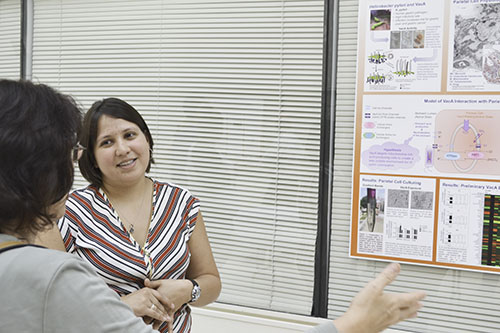
SRTP participant, Kalinda Clark, presents her research.
Clark’s research was on a toxin that lives in the human stomach known as vacuolating cytotoxin and how it “targets the acid secreting cells or parietal cells in order to create a colonizable environment for pylori to live.” Even though she was already highly experienced in research, she claimed this research experience was still very valuable to her academically. “It definitely solidified that I do want to go into this. The research aspect of infectious diseases and veterinarian medicine and it definitely fueled my love for research even more.”
In fact, Clark hopes that after a bit more work, her study will be published! She plans on continuing working on the study this fall in order to make it happen. She’s very proud of what she accomplished during the project, stating: “It was my brainchild. I came up with this protocol… and it ended up working!”
One day, Clark hopes to go into public health veterinary medicine, with her dream job being to work in the CDC Epidemiology department.
Story by: Patrick Pavilonis, I-STEM Undergradute Student Worker and a junior studying Math and Science Education
Photographs by: Elizabeth Innes, Communications Specialist, I-STEM Education Initiative
For more related stories, see: Funded, Summer Research, Vet Med, 2017
For additional I-STEM articles about Veterinary Medicine, see:
- Vet Med Students Gain Knowledge, Skills During Summer Research Training Program
- 2015 Vet Med Open House Offers Visitors Hands-On Learning Opportunities
- Vet Med Open House Appeals to Young and Old Alike

Third Year Vet Med student Nicole Sidebotham presents her research.













.jpg)
















